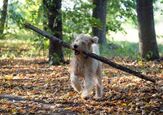How to Introduce a New Pup Without Making Your Resident Dog Jealous
Bringing a new dog into your home is a big decision—one that affects not just you, but also your current four-legged family member.
While dogs are naturally social animals, they’re also sensitive to changes in their environment, routine, and your attention.
Without the right approach, your first dog might experience jealousy, stress, or even behavioral issues.
Here’s how to keep tails wagging on both sides.
Table of contents
1. Spend time prepping your first dog
Before your new dog even steps paw in the house, take some time to prepare your current dog emotionally and behaviorally.
This means strengthening your bond and ensuring they are comfortable with basic obedience commands.
Having a well-behaved and confident resident dog will make managing the first introductions much easier.
It also helps to invest extra quality time in your first dog during this period. Reinforce their role in your life with one-on-one walks, play sessions, or simply cuddling on the couch.
This lets them feel secure in your affection and reduces the risk of jealousy once your attention is divided.
2. Choose the right setting for their first meeting
One of the most common mistakes when introducing a new dog is bringing them directly into the home. This can make your current dog feel that their territory is being invaded.
Instead, arrange for their first meeting to take place in a neutral location, such as a quiet park or open field, where neither dog feels the need to defend their space.
Allow both dogs to approach each other naturally while on leash. Let them set the pace. If they seem relaxed and curious, that’s a good sign.
But if either dog shows signs of discomfort, such as growling, staring, or stiff posture, it’s best to calmly separate them and try again later.
Sometimes, walking the dogs side by side with a bit of distance can help them get used to each other’s presence without the pressure of direct interaction.
3. Carefully introduce the new dog at home
Once the dogs have had a successful meeting outdoors, it’s time to bring them home.
Let your current dog enter the house first. This gives them a sense of control and avoids triggering territorial behavior. Bring the new dog in calmly, and keep the atmosphere as low-key as possible.
At first, it’s wise to keep feeding stations, toys, and sleeping areas separate. Resource guarding can occur even between friendly dogs, especially in the early stages.
Give each dog their own space to retreat to, and supervise their time together closely for the first few days or weeks.
4. Stick to a consistent routine
Dogs thrive on predictability. One of the best ways to prevent jealousy is by keeping your original dog’s routine as normal as possible.
Feed them at the usual times, take them on familiar walks, and maintain any existing rituals you shared before the new dog arrived.
Disruptions to daily structure can make a dog feel displaced. By keeping things consistent, you reassure your first dog that their place in your life hasn’t changed.
5. Divide your attention thoughtfully
It’s natural to want to give the new dog extra love and support, especially if they’re a rescue or a puppy. But your first dog may interpret this as favoritism. Be mindful of how your attention is distributed.
Greet your resident dog first when you come home, and be intentional about offering praise and affection to both dogs throughout the day.
Spending individual time with each dog also helps. This doesn’t have to be elaborate, just a short walk, a training session, or even a few minutes of play.
These one-on-one interactions reassure both dogs and help build your bond with each of them separately.
6. Be patient
Some dogs become best friends overnight. Others take weeks, or even months, to fully accept a new canine companion.
Don’t rush the process. Continue to monitor their interactions, and praise calm or playful behavior.
It’s completely normal for dogs to set boundaries with each other, but any signs of persistent aggression or severe stress should be taken seriously.
In such cases, a certified dog trainer or behaviorist can help guide you through the process safely.
7. When in doubt, ask for help
Even with the best intentions, some dog pairings take extra work. If jealousy turns into growling, snapping, or anxiety in either dog, it’s worth seeking help from a professional.
Trainers and animal behaviorists can offer tailored strategies to reduce tension and support healthy socialization between your dogs.
Final thoughts
Introducing a new dog to your household doesn’t have to mean drama or rivalry. With a bit of preparation, patience, and consistency, you can help both dogs feel secure and valued.
Do you have any tips of your own? Share them in the comments down below.
Join the PetGuide community. Get the latest pet news and product recommendations by subscribing to our newsletter here.
More by Rachel M.


























